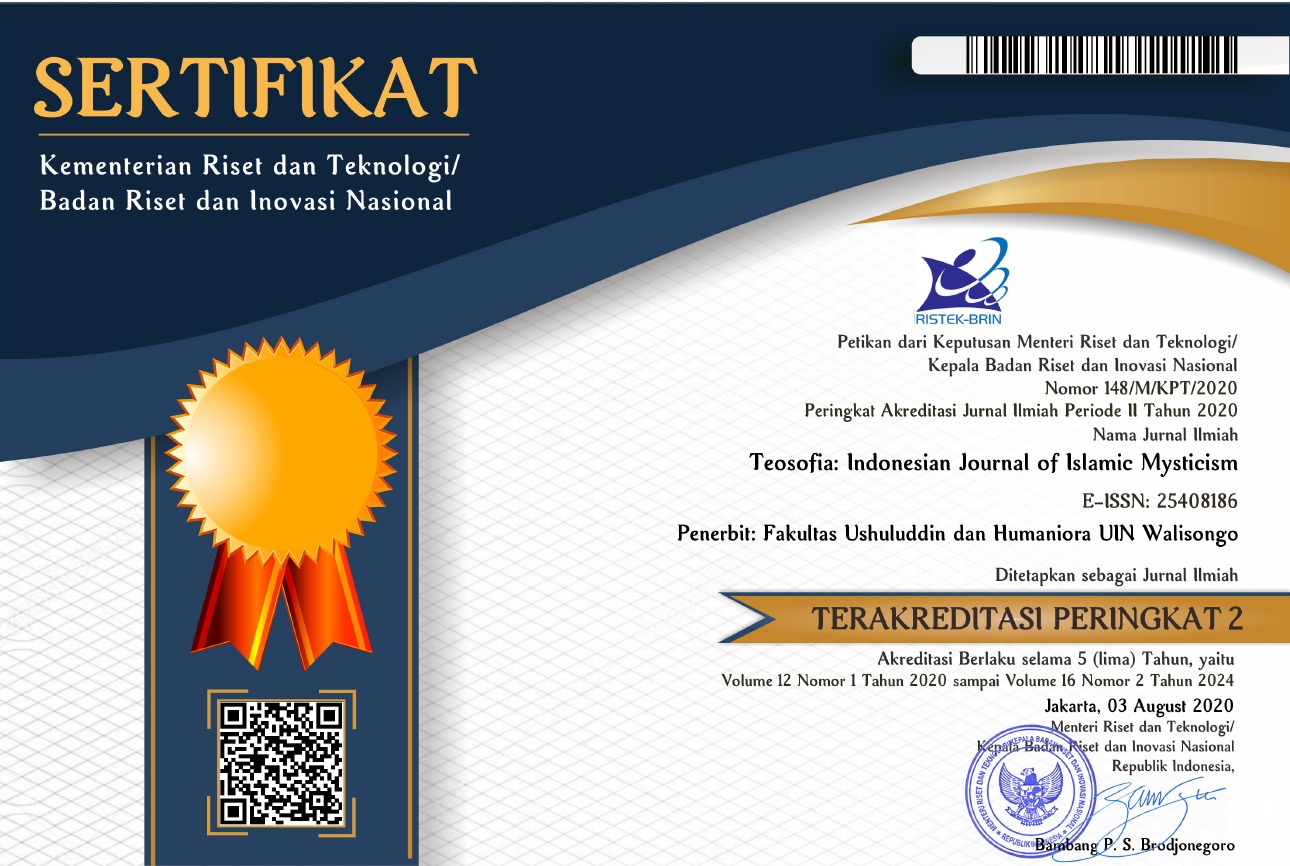QUESTIONING THE “KOREAN WAVED” HIJAB STYLE IN INDONESIA: A CONTEMPORARY QUR’ANIC APPROACH
DOI:
https://doi.org/10.21580/tos.v9i1.5365Keywords:
Korean Wave, Hijab, Indonesia, Synchronic-Diachronic ReadingAbstract
Innovations on hijab have implications for the expansion of its users. Thus it encourages the growth of new identities for hijab which are then expressed by enriching its style, form, color tone, and fabric. The cultivation of hijab throughs the pop-culture of Korea arose and known as the “Korean waved” hijab. This paper has an opportunity to elaborate on hijab’s contemporary progression worldwide. It reflects the Korean pop-culture and identifies the authenticity of the tradition of wearing the hijab in Indonesia. It problematizes the issue of Korean hijab style and how the Quran responds to it. The research framework used a sequential exploratory model henceforth resulting in a scientific response to the phenomenon of Korea's creative industries in the making of an authentic Indonesian hijab model. The results answered the challenges of the vision of "Making Indonesia 4.0" in developing the industrial sector of textile in Indonesia by tracing ethical, aesthetical, and economic modes of hijab.Downloads
References
Abdullah, M. Amin. Islamic Studies di Perguruan Tinggi: Pendekatan Integratif-Interkonektif. Yogyakarta: Pustaka Pelajar, 2012.
Ahmad, Imtiaz. “Why Is the Veil Such a Contentious Issue?” Economic and Political Weekly 41, no. 49 (June 5, 2015): 7–8.
Al-Dayrani, A. K. John Alias, and Mohammad Amin Sheikho. Islam! What Are the Veil, Divorce, and Polygamy for?: A Dialogue between a Western Orientalist and a Muslim Savant. Munich: BookRix, 2014.
Ar-Rifa’i, M.N. Kemudahan Dari Allah: Ringkasan Tafsir Ibnu Katsir. Vol. 3. Jakarta: Gema Insani, 2012.
Auda, Jasser. Maqasid Al-Shariah as Philosophy of Islamic Law: A Systems Approach. London: International Institute of Islamic Thought (IIIT), 2008.
Basith, Rizal. “Bukan Masalah Upah, Ini Penyebab PHK di Industri Tekstil.” kontan.co.id, September 16, 2019. http://nasional.kontan.co.id/news/bukan-masalah-upah-ini-penyebab-phk-di-industri-tekstil.
Bowen, John R. Religions in Practice: An Approach to the Anthropology of Religion. 2nd ed. Massachusetts: Routledge, 2017.
———. Why the French Don’t Like Headscarves: Islam, the State, and Public Space. Princeton University Press, 2008.
Daud, Fathonah K. “Jilbab, Hijab dan Aurat Perempuan: Antara Tafsir Klasik, Tafsir Kontemporer, dan Pandangan Muslim Feminis.” Al Hikmah: Jurnal Studi Keislaman 3, no. 1 (March 1, 2013). https://doi.org/10.36835/hjsk.v3i1.363.
Davies, Paul. Mind of God: The Scientific Basis for a Rational World. New York: Simon and Schuster, 1993.
Dewi, Oki Setiana. Hijab I’m in Love! Bandung: Mizania, 2013.
Fadl, Khaled Abou El. Speaking in God’s Name: Islamic Law, Authority and Women. England: Oneworld Publications, 2014.
Feener, R. Michael, Patrick Daly, and Anthony Reed. Mapping the Acehnese Past. BRILL, 2011.
Ibrāhīm, Rajab ʻAbd al-Jawwād, and Maḥmūd Fahmī Ḥijāzī. Mu’jam al-Arabi li Ism al-Malabis. 1st ed. Riyadh: Al-Afaq Al-Arabiyya, 2002.
Korteweg, Anna C., and Gokce Yurdakul. “The Headscarf Debates: Conflicts of National Belonging.” Routledge 19, no. 2 (2014): 272–73. https://doi.org/10.1080.
Lazreg, Marnia. Questioning the Veil: Open Letters to Muslim Women. New Jersey: Princeton University Press, 2009.
Leigh, Barbara. Hands of Time: The Crafts of Aceh. Jakarta: Penerbit Djambatan, 1989.
Makluf, Louis. Al-Munjid fi al-Lughah wa al-Adab wa al-A’lam. Beirut: Matba’ah al-Istiqamah, 2004.
Maraghi, Ahmad Musthofa al-. Terjemah Tafsir Al-Maraghi. Vol. 6. Semarang: Toha Putra, 1987.
Muhammad, Husein. Perempuan, Islam & Negara: Pergulatan Identitas dan Entitas. Yogyakarta: Qalam Nusantara, 2016.
Mustaqim, Abdul. Epistemologi Tafsir Kontemporer: Studi Komparatif antara Fazlur Rahman dan Muhammad Syahrur. Disertasi. Yogyakarta: UIN Sunan Kalijaga, 2007. http://digilib.uin-suka.ac.id/14300/.
Nadjib, Emha Ainun. Syair lautan Jilbab. Al-Muhammady, 1989.
Nordholt, Henk Schulte. Perspektif Baru Penulisan Sejarah Indonesia. Jakarta: Yayasan Obor Indonesia, 2008.
O’Brien, Peter, ed. “Veil.” In The Muslim Question in Europe, 307. Political Controversies and Public Philosophies. Pennsylvania: Temple University Press, 2016. https://www.jstor.org.
Oxford University Press. “Hijab.” Oxford Dictionaries | English, December 4, 2018. https://en.oxforddictionaries.com/definition/hijab.
Qurthubi, Al-. Tafsir Al-Qurtubi. Edited by Abd Allah ibn Abd al-Muhsin al-Turki. Jakarta: Pustaka Azam, 2009.
Riduwan, Faizol. “Makna Jilbab Bagi Komunitas Hijabers Surabaya.” Undergraduate, UIN Sunan Ampel Surabaya, 2013. http://digilib.uinsby.ac.id/11181/.
Riyanto, Ahmad. Relasionalitas Filsafat Fondasi Interpretasi: Aku, Teks, Liyan, Fenomen. Yogyakarta: Kanisius, 2018.
Saluz, Claudia Nef. Islamic Pop Culture in Indonesia: An Anthropological Field Study on Veiling Practices among Students of Gadjah Mada University of Yogyakarta. Bern: Institut für Sozialanthropologie, Universität Bern, 2007.
Shahab, Husein. Hijab Menurut Al-Qur’an Dan Sunnah: Pandangan Muthahhari Dan Al-Maududi. Bandung: Mizania, 2013.
Shihab, M. Quraish. Tafsir Al-Misbah: Pesan, Kesan, Keserasian al-Qur’an. Jakarta: Lentera Hati, 2002.
Shirazi, Faegheh. The Veil Unveiled: The Hijab in Modern Culture. Florida: University Press of Florida, 2003.
Siauw, Felix Y. Yuk, Berjilbab! Bandung: Mizania, 2013.
Smith, Holly Susan. Aceh: Art and Culture. Oxford University Press, 1997.
Tantowi, Ali. “The Quest of Indonesian Muslim Identity: Debates on Veiling from the 1920s to 1940s.” Journal of Indonesian Islam 4, no. 1 (June 1, 2010): 62-90–90. https://doi.org/10.15642/JIIS.2010.4.1.62-90.
Taufik, Egi Tanadi, and Hadi Wiryawan. “Peran Hadis dalam Asbāb al-Nuzūl Jadīd: Kritik Hermeneutika Otoritarian Abou Fadl terhadap Metodologi Tafsir Kontemporer M. Amin Abdullah.” In Urgensi Studi Hadis di Indonesia pada Era Milenial, 219–62. Jember: STDII Press, 2018. https://www.academia.edu/42913663/.
Yatim, Danny. “Hallyu, the Korean Wave.” The Jakarta Post. February 13, 2017, sec. Art & Culture. www.thejakartapost.com.
Yusuf, Muhammad. “Pendekatan Sosiologi dalam Penelitian Living Qur’an.” In Metodologi Penelitian Living Qur’an dan Hadis, edited by Sahiron Syamsuddin and Muhammad Alfatih Suryadilaga, Cetakan I., 35–64. Yogyakarta: Teras, 2007.
Zempi, Irene, and N. Chakraborti. Islamophobia, Victimisation and the Veil. 1st ed. United Kingdom: Palgrave Macmillan, 2014.
Downloads
Additional Files
Published
How to Cite
Issue
Section
License
Copyright
The copyright of the received article shall be assigned to the journal as the publisher of the journal. The intended copyright includes the right to publish the article in various forms (including reprints). The journal maintains the publishing rights to the published articles. Therefore, the author must submit a statement of the Copyright Transfer Agreement.*)
Licensing

This work is licensed under a Creative Commons Attribution-ShareAlike 4.0 International License.
In line with the license, authors are allowed to share and adapt the material. In addition, the material must be given appropriate credit, provided with a link to the license, and indicated if changes were made. If authors remix, transform or build upon the material, authors must distribute their contributions under the same license as the original.
_______
*) Authors whose articles are accepted for publication will receive confirmation via email and send a Copyright Transfer Agreement.









